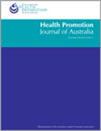When confrontational images may be counter productive: reinforcing the case for pre-testing communications in sensitive areas
Abstract
Issue addressed
White Ribbon Day is an international campaign that encourages men to speak out about and demonstrate their opposition to violence against women by wearing a white ribbon on 25 November. This study assesses the effectiveness of a graphic confrontational image in the Australian 2006 campaign versus an alternative non-violent image to motivate men to wear a white ribbon on White Ribbon Day.
Methods
An intercept survey was conducted with a sample of 45 males aged 30–49 years recruited in an inner city suburban shopping strip. Respondents were presented with two alternatives: a graphic ‘amputated arm’ image and a non-violent ‘father-daughter’ image. The primary dependent variable was the relative ability of the two alternatives in motivating respondents to wear a white ribbon on White Ribbon Day.
Results
The vast majority of respondents nominated the ‘father-daughter’ as image being more motivating than the ‘amputated arm’ image to wear a white ribbon on White Ribbon Day: 84% vs 9%.
Conclusions
The bland ‘father-daughter’ image was far more motivating than the macabre/violent ‘amputated arm’ image in motivating men to wear a white ribbon on White Ribbon Day. This is contrary to the UNIFEM Australia and White Ribbon Day assertion that ‘confrontational/provocative’ images are necessary to achieve this behaviour.
So what?
Confrontational images may be counter productive. Hence pre-testing of potentially controversial images is necessary, especially in sensitive areas such as violence against women and when funds for campaigns are limited.




